Long-tailed Weasels are obligate carnivores (eat meat exclusively), preying largely on smaller rodents but also take rabbits, chipmunks and birds – including poultry. They take down prey several times their size and occasionally go on killing sprees triggered by the smell of blood.
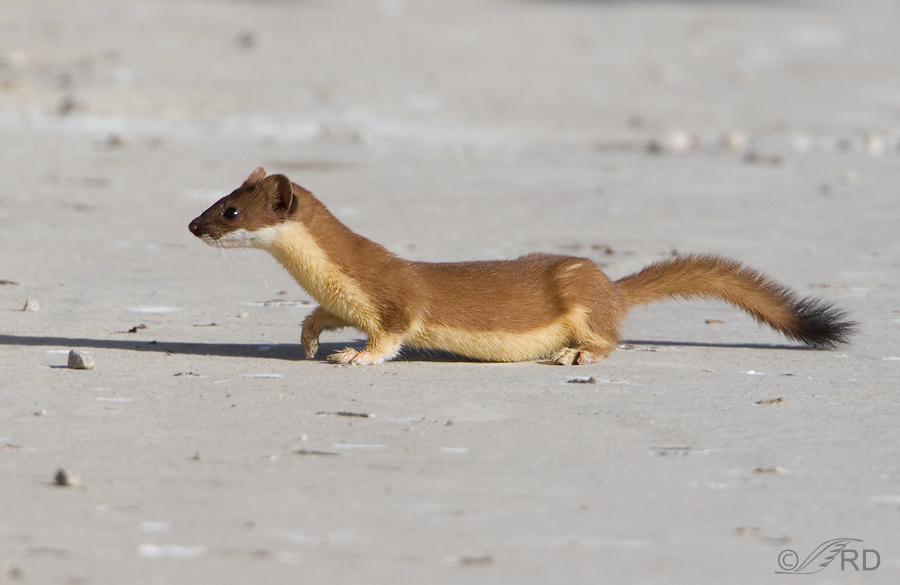
Long-tailed Weasel, summer molt
Their long black tipped tail, slender bodies and darker brown coloration above with creamy white ventral parts are identifying features. The very similar Short-tailed Weasel is smaller and has whiter feet.
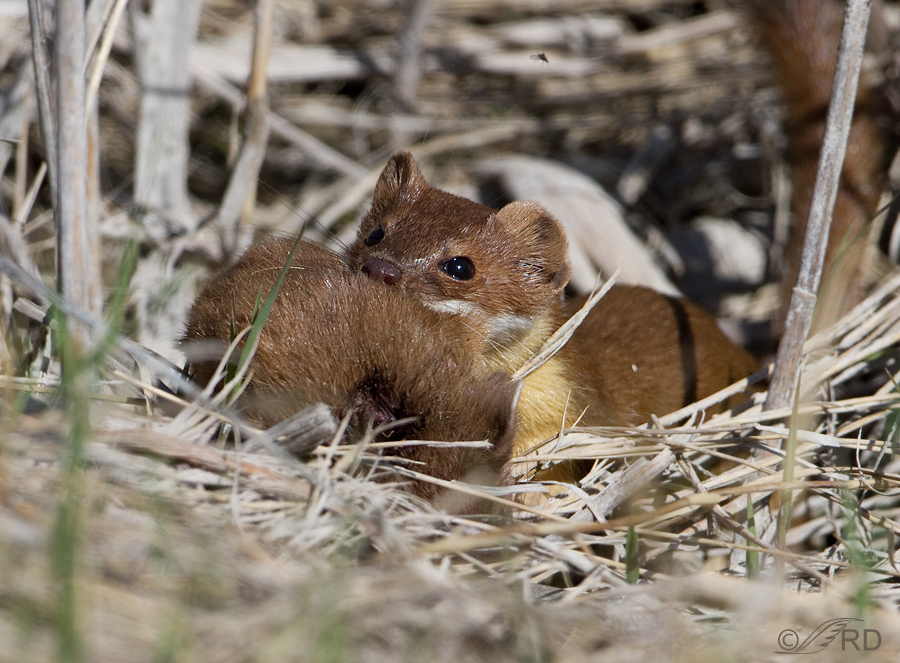
In this case the prey is another weasel
While driving the loop road at Bear River Migratory Bird Refuge this weasel ran in front of us carrying another weasel that it had apparently killed. Weasels are cannibalistic at times and I’m relatively certain that this kill was destined as a meal rather than the kill being made simply out of aggression because the winning weasel was very reluctant to abandon its prize even with us very close. It took a great effort for the weasel to carry its long-bodied kin through the grasses and reeds and it simply would not abandon it.
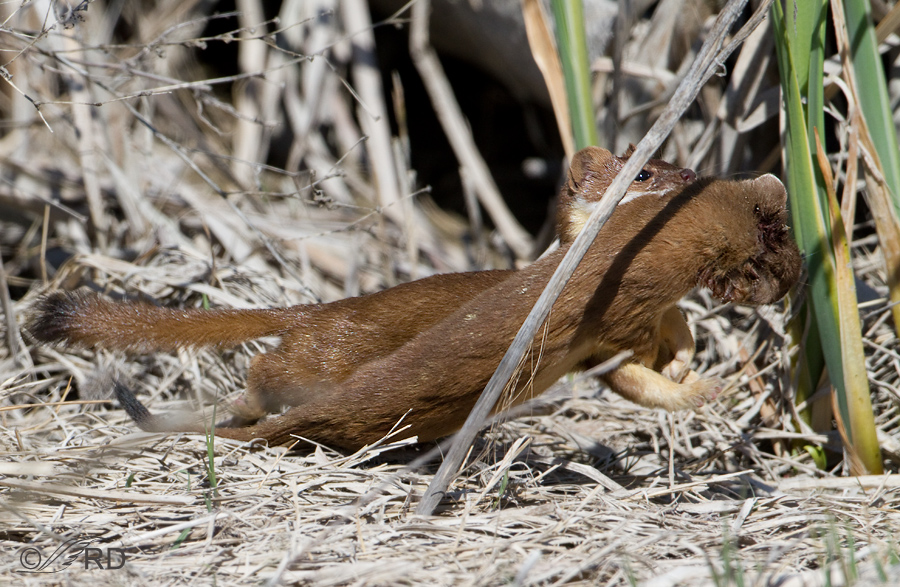
Hopping with it’s prey
Here you can get a feel for how difficult it was to drag the long body through all the obstructions so most of the time it would hop forward, one jump at a time, presumably with its burrow as a goal.

Long-tailed Weasel, winter molt
As winter approaches, northern weasels molt to white (while retaining the black tipped tail) – the advantage of this is obvious. Interestingly, many weasels living in the southern part of their range do not turn white. This color change is genetically determined since northern weasels captured and taken south still turn white in winter while southern weasels transported north remain brown.
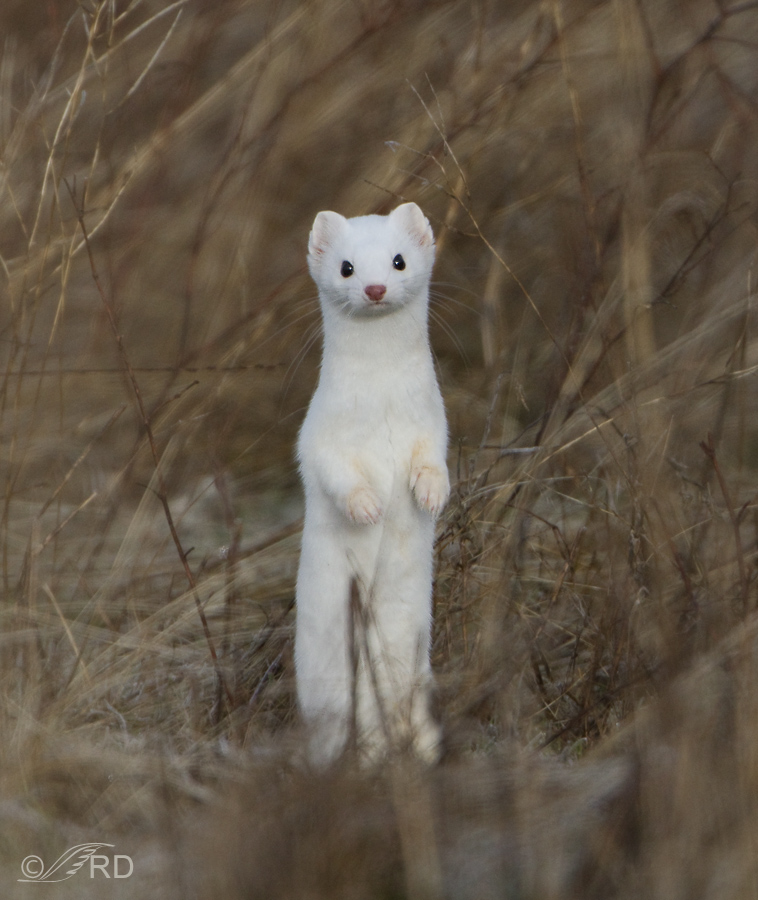
Winter molt
Many call white Long-tailed Weasels in winter “ermines” but this is technically incorrect. Only the Short-tailed Weasel is correctly called the ermine.

Weasel with a vole it has killed
It’s fascinating to watch these efficient killers hunt. I observed this weasel hunting in front of a Phragmites stand and was transfixed by its sinuous and seemingly effortless movement over rocks and other obstacles. It had this vole in its jaws in an instant with what seemed like no real effort expended. I was very impressed with its prowess.
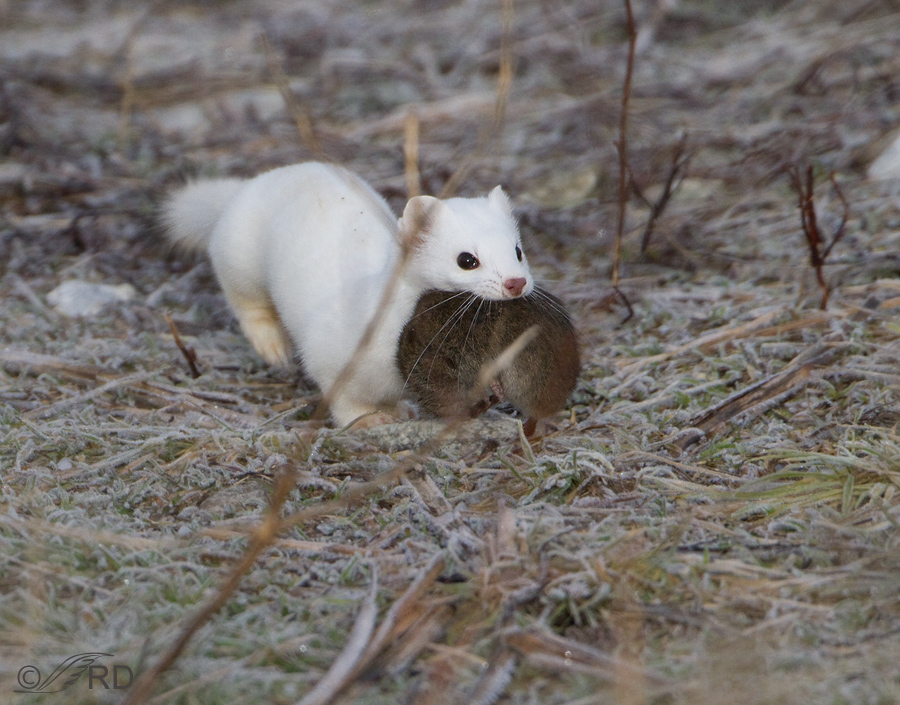
Weasel with the same vole
After capturing and killing the vole it would stop and look at me then take a few bounding jumps and then stop and look at me again. It soon disappeared in the grasses with its prize. I had a very difficult time getting any clear shots of it through all the vegetation.
I’ve always been fascinated with the entire Mustelid family – weasels, Badgers, Martens, otters, skunks, Fishers, mink, ferrets and Wolverines but I’ve had very little luck photographing them. Hopefully, that will soon change.
Ron
Note: A comment on a later weasel post by Master Falconer Mark Runnels brings into question my assertion that some of the photos here were related to cannibalism. Marks fascinating comment is below:
I don’t know anything about weasels, but we keep their close relative, ferrets, to hunt with our Harris’ hawks. If the rabbit goes into a hole in the ground, or more commonly, into a piece of oilfield pipe, we can send the ferret down to get it moving again.
Several years ago, when I was in college (yikes! that was 25 years ago!) I decided that I wanted to breed my jill (female) and raise a litter of kits. The owner of the male tried to warn me not to watch, but I was interested in anything related to ferret biology, so I stuck around. Ferret breeding is a violent business! The much larger hob (male) male grabbed my jill by the scruff of the neck neck and beat her head against the hardwood floor, furniture, or any other hard surface he could find. This continued for several minutes until she was completely unconscious after which time he drug her limp body around the room for several minutes before finding a quiet corner and copulating with her several times. Once she regained consciousness, the two carried on as though nothing unusual had happened. I am not usually squeamish, but I could never again breed one of my jills and started having them spayed. Natural or not, I didn’t have the stomach to watch that again! I have since learned that this behavior is normal and is typical of minks as well, but not skunks.
Why am I sharing this disturbing behavior with you? I got to wondering it the cannibalistic weasel in your earlier post had really killed one of its kin and was carrying it off to be eaten, or is it possible that the breeding habits of the weasel are similar to the ferret and this was a male that had knocked out a female and was dragging her off to breed with the unconscious body in a quiet location somewhere?
As I said, I know nothing about weasel biology, but it is an interesting question.
Thanks for the great pictures.
Mark


Well I learned something new today that’s for sure !! So please tell me , if what I think I have in my attic is a weasel , that would explain several mysteries . I’m in the country , I no longer see any mice , I saw something white go flying up a choke cherry tree last night after dark , and there is a slightly fowl scent every now & again . Any suggestions on how to evict it from the attic & keep it out ???
From what you’ve said it sounds like it very well could be a weasel, Eric. They’re mustelids which would explain the scent. The only thing that surprises me a little is that you said that it’s already white. They usually don’t turn white until later in the fall but that partly depends on how far north you live. If you see it again look for the black-tipped tail. If it has that, it’s a weasel.
I really liked your pictures . We have lots of rabbits at our house and we have field mice. I was watching our rabbits play out side when I saw a weasel jump out from under our house and walk up to me. It went back to its hole where its friend came out with him and he walked back up to me then home again. Ive never saw one befor it was cool! Thanx again for the pics.
While sitting on a stump, looking out at Racquette Lake in the Adirondacks, one morning, I heard a funny “chucking” sound and saw a family of minks slipping along the rocks at the water’s edge. To my surprise, delight and great discomfort (when I remembered how fast they are and how sharp their teeth are), they detoured up to my stump, darted around my feet, briefly, then took off back to the water and disappeared down the lake. Magical, but scary!
I love weasel but my brother keep calling me a weasel xxx
My Mom has had a weasel in her house. Do they have scent glands and leave a scent? She’s noticing a smell.
Carrie, Yes, weasels are mustelids and as such have anal scent glands. I’ve never smelled the weasel’s scent but I have smelled that of Mink and it’s not very nice when it’s strong.
I am not sure but I think I may have a long tailed weasel in my yard. I was outside with my dog and there it was chasing a rabbit of all things. I have never seen one before in my yard. But there it was in its white coated glory chasing its dinner.
If it had a white coat it’s most likely a weasel, Melissa. Did it have a black-tipped tail? They’re fericious little critters and often their prey is much larger than themselves so the rabbit doesn’t particularly surprise me. They’re well known for killing full grown chickens.
TodayI heard a splashing which turned out Not to be my turtle sliding off his basking bridge into the water of his tank. It was a white longtailed weasel in my bathroom toilet!
I thought it was a white rat but then noticed the long neck and black tipped tail. How it got in my toilet I don’t know. We do live in the country and have a septic tank system. Thoughts?
Thanks for the info nd photos.
Wow, that’s quite the episode Kathleen! Never heard of such a thing.
First off, how far north do you live? I’m slightly surprised they’d have their complete white coat already unless you live in a very cold climate. Any mice or other small rodents (pets or otherwise) in the house? If so, it could be after them but that toilet thing is a complete mystery. Unless it’s potty trained…:)
We live in northern MN 90 miles from the Canadian border. We just have the turtle and a cat who occassionally proudly brings us a field mouse she has caught. The cat has food and water feeders available as well so can’t imagine it was looking for water. Still, that seems more likely than swimming up throught the plumbing!
I will keep my eye out for others on the property.
P.S. Must have been a short tail – feet were white.
Interesting that they’ve got their white coats already Kathleen, even up there.
This is a common problem. There is a plumbing vent on your roof somewhere that has a broken filter. You need to repair the filter otherwise you will get squirrels and other critters going in and possibly clogging your drain. See this webpage for more info: http://www.squirrelventshield.com/about.html
Makes sense. Never thought of that. Thanks, Frank.
Great photos Ron. I run a unique pest control company that provides wildlife rescue and ‘no kill’ management on the Washington coast. Good photo’s of this animal are exceedingly rare. With your permission I would like to use one of these photos in our homeowner education newsletter.
We would very much like to use one of these images in a book we are currently working on entitled:
The Dark Side of Evolution: Cannibalism ISBN: 978-1-908062-71-0
Could you possibly let us have your contact details so we can send you more information/request copyright permission.
Thank you.
Thanks for your interest Sarah. I have emailed you my contact info.
Hi Ron,
My daughter is doing a kindergarten project on weasels and their habitat. I’d like to show the kids a picture of what the long tail weasel looks like with its white coat and one with it killing prey (I have a stuffed brown one for the project). May I use two of your pictures on her project?
Thanks,
Kathleen
Kathleen, I’d be happy to donate the use of two of my weasel photos for classroom use by your daughter. Yes, you may use them for that purpose.
Thank-you so much! Your pictures are amazing and you are most generous to share them.
Kim, Though weasels are well known for taking prey larger than themselves I’m sure your cats have nothing to worry about. This species only weighs from 3-9 oz so your cats would be, on average, 36 times heavier than a weasel. That plus the fact that cats are carnivores well equipped to defend themselves would make them safe from attack I’m sure.
Ron
Thanks for the pictures as I have just a few moments ago discovered what I believe to be a weasel. Upstairs in the barn while rolling out some straw my dog was very interested in something under a piece of plywood. I lifted it up to discover a very white, long nosed weasel. Couldn’t see the tail as I didn’t want to get him or the dog in any trouble. Thanks for the pics!
Glad you enjoyed the photos Denise. It’s quite typical to find weasels in barns and other outbuildings where they often hunt for mice.
will weasels bother our cats? they are about 12 lbs. each.
thank you!
Very nice pictures! I just saw one out the window of where I work (stone fence of boulders) and it was moving very quickly, so I can appreciate how hard it is to get a good picture of one. The weasel was white with the black tip – a Wisconsin weasel – carrying something in its mouth, about mouse-size. Thanks for posting these.
I’m a big fan of the family also, Ron. I have very fond memories of some pine martens I’ve seen while backpacking in Colorado. Playful, curious, beautiful creatures–and tough little predators too!
I echo Rich’s sentiments Ron. What a great find and as usual, superbly photographed. Now if I could capture an image of the Fisher that’s been frequenting my yard…
Awesome! I am very jealous of this experience and these images.
Thank you for both the compliment and the suggestion Theo. I think you’re right, so starting with my next post I’ll include image techs. I considered going back and adding them to this post but since I was set up to shoot Northern Harriers in flight when this weasel suddenly appeared, my techs weren’t very appropriate for the situation anyway. Thanks for your input.
Ron
I love your blog, Ron. And the fact that you are so willing to share your shots and stories with us aspiring wildlife photogs. Your stories add so much to the shots. Sometimes, a little more teknospeak would be appreciated (shutterspeed, ISO, etc.) also, at least, it’ll keep ME reading ’cause I learn from those details. Keep up the good work!
Theo